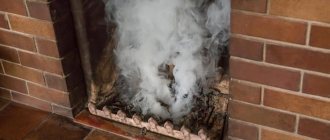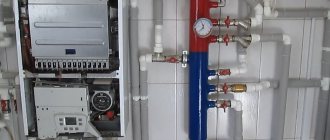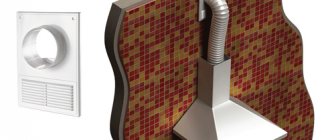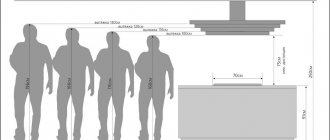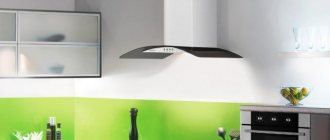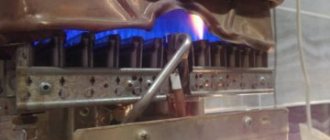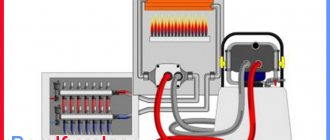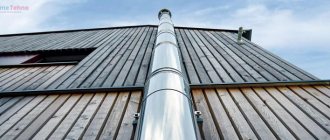How often should you clean your hood?
First, a little theory. Ideally, you should clean the hood once a month - this is when kitchen processes are at medium activity. If the family is large and you have to fry and steam frequently, then it is better to clean the filters once every couple of weeks . If there is not very much activity in the kitchen, you can reduce the frequency of cleaning to once every 2-3 months . If you follow this rule, then each cleaning will take a minimum of time, because fresh plaque is removed without extra effort.
What happens if you don’t clean your hood on time? Here are the main consequences:
- decrease in the effectiveness of the main function - a clogged filter does not catch dirt and grease so well, so the degree of air purification in the kitchen will gradually decrease;
- increased noise levels;
- deterioration in the appearance of the hood, because not only the insides, but also the body suffer from fat;
- complete failure.
Once every 1.5-2 years it is recommended to completely disassemble the hood and lubricate the motor.
Removing dirt from buttons and inner surfaces
When dirty, buttons and control panels are cleaned with specialized sprays. The cleaner is sprayed onto the contaminated area and wiped dry with a napkin. The most commonly used folk remedies are hydrogen peroxide, ammonia, anise drops, and nail polish remover. Apply the product to a cotton pad or swab and carefully wipe the buttons, remembering to press them and treat the connector. An old toothbrush can help remove dried grease.
The inner surface of the hood should be washed once a quarter, and it can be treated with the same products as the body. If the pollution is old, “Mole” will cope with it, but it should not be abused. After cleaning, thoroughly wash the surface with clean water and dry or wipe dry.
How often to clean the kitchen hood
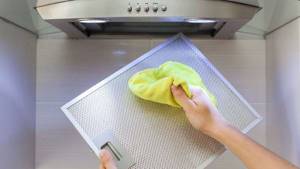
In order for the hood to truly clean the air, manufacturers recommend washing the device regularly - at least once a month.
In reality, you should focus on the intensity of kitchen work:
- In small families in which, for example, only a kettle and coffee machine are used in the kitchen, and food is not prepared but ordered, it is recommended to wipe the hood from dust with a damp cloth as it becomes dirty. The filter can be cleaned every few months.
- Active housewives, who cook and steam for a large family from morning to evening, should clean the hood often - once every 10-14 days. In modern models, you need to focus on the hood signal: when the sensor reports the need for cleaning, you cannot hesitate.
Old grease hardens and is difficult to clean off. It will have to be torn off, damaging the surface of the case. The grease filter serves to protect the motor: when it is dirty, the load on the unit increases. The noise level increases, the device operates with overload.
How to clean hood filters?
The efficiency of a kitchen hood depends not only on the power of the motor. High-quality air filtration is impossible without reliable filters that “retain” fat particles and other impurities (gas combustion products, steam, soot). Over time, the filters become dirty, which increases the load on the engine and makes the air less clean. Keeping your kitchen helper in perfect condition is easy! We will tell you how to clean hood filters, what types they are and how to install them. There are 2 types of filters:
• coarse cleaning (grease or grease);
• fine cleaning (coal).
Grease filters
The first type of filters is provided in all hoods, regardless of the class and supported operating modes. This is a metal mesh or a special perforated metal sheet. As the name suggests, the main task of such filters is to capture the smallest particles of fat, as well as soot and soot. Grease filters protect the motor and blades from contamination, which ensures efficient operation of the hood.
How to wash hood filters? Everything is quite simple.
1. Turn off the hood.
2. Remove the mesh. Information on how to do this can be found in the manufacturer's instructions. For example, in Pyramida hoods you need to press a special lock. 3. Using a soft sponge, thoroughly rinse the filter with warm water and detergent (soap, dishwashing detergent). 4. Dry and you can return the mesh to its place. This procedure must be carried out as soon as it gets dirty. As a rule, cleaning is required every 3-6 months - it all depends on how often you cook and turn on the hood.
Please note that in addition to reusable filters, there are also disposable ones. In some models, additional coarse filters made of synthetic material are installed. When they become dirty, they need to be replaced with new ones. Grease filters made of paper are also available. Their service life is about 6 months. Both synthetic and paper analogues are practical and functional, do not require cleaning, but are relatively expensive for the family budget.
Carbon filters
It is not always possible to connect a hood to a ventilation shaft and use the device in the most efficient air removal mode. In such cases, carbon filters help get rid of unpleasant odors. They are installed in hoods operating in recirculation mode. The air flow passes through a grease filter, then through a carbon filter, and then returns back to the room. In essence, we get a 2-layer filtration system.
How to clean a hood's carbon filter? No way. This filter is disposable and must be replaced with a new one on time. If you use the hood every day, the carbon filter will last 3-4 months. If you turn on the hood less often, the service life can increase to six months. A dirty fine filter can reduce the efficiency of the hood by almost 50%! To avoid this, monitor the condition of your kitchen assistant and change the filter on time. This procedure will take literally a few minutes.
1. Turn off the hood.
2. Remove the grease filter. 3. Remove the old carbon filter. 4. Install a new one in its place. 5. Place the metal mesh and you can turn on the hood again. Important! Follow the manufacturer's recommendations. The user manual contains all the necessary information on operating the equipment. Make sure that the new fine filter matches the model of your hood.
Pyramida hoods use efficient carbon filters made from coconut shells. Just 50 grams of this coal will absorb up to 250 grams of impurities!
Follow our advice and forget about clouds of steam, unpleasant odors, and particles of soot and grease hanging in the air. Clean air is the key to a comfortable stay in the kitchen for both the housewife and all family members!
www.pyramida.ua
Where to start working at home
The first thing is to read the instructions. Cleaning will require partial disassembly of the unit, so you cannot do without instructions. Then you need to do this:
- disconnect the device from the power supply, unplug the plug from the socket;
- remove the grease filter;
- If necessary, remove the carbon filter.
The carbon filter does not require cleaning, but replacement. If you cook frequently in your home, change the filter every 5-6 months.
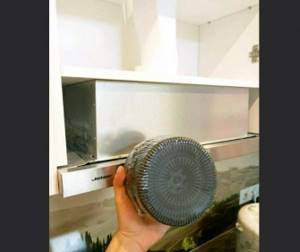
The carbon filter is not cleaned, but replaced
Preparation is a responsible process: how to wash grease from a hood over the stove
It is clear that you can wash and clean the hood above the stove in the kitchen only when you have a clear idea of what to do. First of all, you should understand that without instructions that would explain everything in detail point by point, you won’t be able to do it the first time, and the most you can do is wipe all the outer surfaces. It is clear that in order to figure out how to clean the hood from grease in the kitchen, you should first prepare, for example, study its design, since the gadget will have to be disassembled.
- First of all, you should remember that the hood must be disconnected from the power supply, otherwise it will not be possible to disassemble it. Although, if you are a lover of risk and extreme sports, and moreover, have the super ability to control electric current, then feel free to disassemble it while the plug is inserted into the socket.
- Next, on the hood itself, according to the instructions, which must have a special diagram, we unsnap the latches and remove the top cover.
- When figuring out how to clean a kitchen hood from grease, it is also worth understanding that the pipe that connects it to the ventilation vent also needs to be cleaned and washed, since nasty and annoying grease manages to accumulate there too. Some craftsmen simply manage to change the corrugated cloth themselves once a month, thereby completely eliminating the unnecessary work of washing them. However, it is worth saying that such numbers do not apply to every hood, and you still need to know how to replace the pipe.
- Next, it’s time to remove the air filter, which is quite easy to remove. Moreover, we will tell you how to wash the hood filter a little later; in fact, it is not at all difficult if you know a few simple tricks and tricks.
- It is clear that no one will remove the hood body itself, which is attached to the wall, although this is all optional. It will be enough to simply wash it inside and out, and proceed to other matters, without any twinges of conscience.
Important information
If you think that all filters in hoods must be cleaned and washed, then you are very mistaken. There are models that can only be changed, and it is simply not possible to wash such filters. Therefore, this information must initially be gleaned from the same good old instructions, which we often begin to read only when the “subject of study” is already broken.
Causes of a clogged hood
The hood has to be cleaned periodically in any case - wash the external parts of the device, change the filters, clean the filter meshes. The cause of contamination is the deposits on the filters, internal and external surfaces of this equipment of all those particles that are drawn in by the operating equipment. Even if you don’t use the stove, hood, or oven at all, dust will accumulate on idle equipment.

The frequency of cleaning depends on specific conditions. It is usually recommended to do this monthly, but some users find the strength to clean the hood of grease and other deposits after each cooking. If you neglect cleaning, your equipment will soon become covered with a layer of grease, soot and other dirt. In this case, the filters will simply become clogged and the equipment will cease to perform its functions. It should be noted that old deposits are not as easy to wash off as relatively fresh ones - even with folk remedies (a bite, for example), or with special dishwashing detergents.
Using a steam cleaner to clean the hood
A good way to remove even stubborn grease from surfaces is with a steam generator. Quite an expensive but effective technique. Under the influence of a temperature of 150 degrees, dirt lags behind the surface. After using a steam cleaner, it is enough to wipe the hood parts with a regular dish sponge. Another benefit of steam cleaning is that it disinfects all surfaces.
Steam generator
This option is not for everyone, since not every apartment has a steam generator. This device produces steam with a temperature of about 1500C, which allows you to literally melt all the fat. Moreover, the surface of the filters is disinfected. After treatment with a steam generator, just wash the filters in warm water and rub with a sponge with detergent or liquid soap - the grease will come off very quickly.
What do you need to know before you start cleaning?
Simply wiping the outer part of the body with the buttons does not mean washing the hood. The device will have to be partially disassembled, and in order to do this correctly, you will need to look at the instructions, which indicate all the design nuances and disassembly rules for a specific model. In general terms, the process of preparing the hood for cleaning is as follows :
- de-energize the device;
- Unclip the latches of the top panel (if equipped) and remove the grease filter. It captures grease particles well and does not need to be replaced - only regular cleaning. The grease filter is usually made of steel or aluminum . The steel option is the best. There are disposable grease filters that are used in the most compact hoods. They are made on the basis of paper, acrylic, padding polyester or non-woven fabric, and need to be replaced every 3-4 months, they cannot be washed;
- remove the carbon filter that is equipped with circulation-type hoods. The carbon filter cannot be washed - it needs to be replaced as it becomes dirty. On average, it is changed every 4-6 months.

Flow-type hoods remove drawn-in air through a ventilation duct to the street. A grease filter is necessary to protect the motor. In this type of hood, cleaning the ventilation duct is sometimes required. Circulating hoods draw in air, clean it and send it back to the kitchen. The cleaner the carbon filter, the more efficient the process, so you should not forget to change it.
What and how to clean the kitchen hood from grease? It all depends on the degree and age of the pollution. Someone will get by with little blood, i.e. the most common detergents, while others will have to work hard using aggressive chemicals.
Common Mistakes
What NOT to do if you clean the hood yourself:
- Turn on the device immediately after washing if you cleaned the inside of the housing. The fan and motor must dry out.
- Wash the disposable filter. They only need to be replaced.
- Clean the plastic filter with steam or pour boiling water over it. High temperatures can deform plastic.
- Use stiff brushes, abrasive cleaners and steel wool to clean the exterior of the cabinet. A smooth surface can be scratched, especially if you rub hard.
- Use alkaline cleaners to clean aluminum filters.
- Use alcohol-containing detergents and solvents to clean the cabinet. After such cleaning, the surface may become dull.
About MBS hoods - review of models with characteristics
Where to make a socket for a hood in the kitchen: placement rules
Related Posts
Method number 1. Any dishwashing detergent
If the fat has not yet had time to eat into the holes in the grease filter and harden firmly, has not acquired a sticky consistency and a dark color, then ordinary dishwashing detergent, which is found in every home, will help.
Procedure:
- find a container where the removed grease filters will fit comfortably (bucket, baking sheet, basin);
- put the filters in a container, apply dishwashing detergent to them;
- pour hot water until the filters are completely under it;
- leave for 30-40 minutes;
- take out the filters and treat each with a metal sponge or brush, trying to get rid of all the softened fat;
- If you couldn’t remove all the fat the first time, repeat the procedure. If the fat is not in a hurry to leave the surface of the filter even after the second time, then you should move on to more serious methods;
- soap residues are thoroughly washed off with water;
- Before installing back on the hood, the filters are completely dried;
- It is better not to keep aluminum grilles in water for too long.
This method is great for regular cleaning of the hood . If, after purchasing the device, you repeat this washing once a month, then you will not need more aggressive and complex cleaning methods.
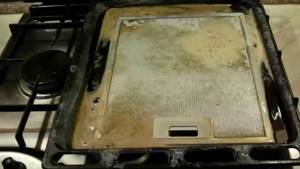
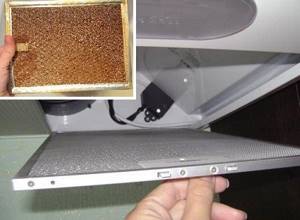
What not to use
Depending on the material of the housing, there are restrictions on the use of methods for cleaning it. You can eliminate contamination without spoiling the appearance of the device by remembering a number of methods and means that must be excluded.
Alcohol based products
In order to wash the outer part of the hood, do not use products that contain alcohol. After cleaning with their use, the material may become dull.
Solvents
Strong solvents will also cause dulling of the surface. It is better to choose a neutral cleaner.

Aggressive cleaning agents
Aggressive cleaning products will help quickly dissolve grease, but will cause irreparable damage to the appearance. They should not be abused. This is another reason why you should not delay cleaning the visible surface of the hood body, but should do it regularly. In this case, a damp dust cloth and dishwashing gel and liquid soap against fresh grease stains will be sufficient.
Hard sponges and brushes
Hard sponges and brushes, especially metal ones, are strictly contraindicated. If you rub the body with them, especially with force, the surface will easily be scratched.
Cleaners containing abrasive particles will have the same effect, so they should also be avoided.
Dishwashing liquid
To clean the hood body, you can use any liquid dishwashing detergent. It will not damage the surface, but will cope with grease stains. Gently wipe the body parts with liquid applied to a soft sponge. After this, rinse off the product with a clean cloth and wipe dry.
Laundry soap
Regular brown laundry soap will successfully remove stains. Simply lather the sponge and wipe the visible surfaces, then rinse off the cleaning agent. Do not wet the cloth with water; use a well-wrung out damp sponge to prevent liquid from getting inside the case.
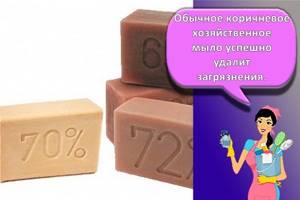
How to make cleaning your hood easier at home?
There are several ways that you will forget what it’s like to stand over the hood for hours, armed with various types of rags and detergents. Top most effective home remedies for cleaning kitchen appliances:

Lemon is an effective filter cleaner
- detergent;
- soda;
- ammonia;
- laundry soap;
- vinegar;
- lemon;
- pipe cleaner.
Signs you need cleaning
A range hood is an indispensable attribute of modern kitchens, which not only removes unwanted odors, but also complements the composition of the interior. In order for the device to perform its functions well and have a beautiful appearance, it is necessary to carry out timely cleaning from the inside and outside, preventing fatty deposits from aging. When using a hood at home, it is recommended to clean it approximately once a month, but there are a number of signs that indicate the need for urgent care:
- On modern equipment, a special sensor is installed with the image of a grille icon or the letter “C”, which lights up at a certain degree of contamination. With such an indicator, it is not at all difficult to understand when to wash the device.
- When there is no sensor, conclusions about the required maintenance can be made based on changes in the hum of the hood. It is necessary to urgently clean it if the sound during operation is uncharacteristic, louder.
- Impaired odor removal. The smell goes away worse and slower than before, you need to choose a more intense mode to effectively eliminate it - cleaning is necessary.
- The easiest way to understand that the hood needs to be washed is by external inspection. By regularly checking visually how dirty the parts are, you can determine that it is time to clean them.
Method 3. How to clean the hood grille with a grease remover (for difficult cases)
Another radical method of cleaning the hood is with a grease remover or oven cleaner. For example, it could be Bugi Shumanit, Bugi Giant, Sparkling Cauldron, Oven Cleaner from Amway and others. Don't forget to open the window and use rubber gloves!
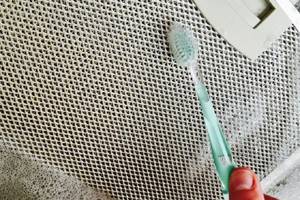
Instructions:
- Treat the hood filter with the product.
- Place the grille in a bag (!) to prevent the pungent odor from spreading throughout the apartment.
- After 10-15 minutes, wash the mesh as usual and rinse thoroughly.
Advice:
- If you have children or pets, it is better to use Amway oven cleaner, as it has almost no odor and works more efficiently than its analogues. True, it is sold only through brand dealers or in the company’s online store.
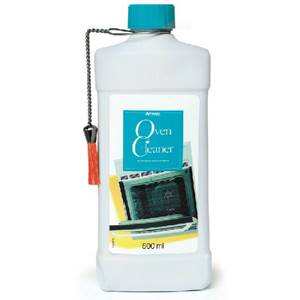
See also: How to clean a gas stove in 8 steps
Preparing to Clean the Grille
Each model of kitchen hood has a manual for disassembling the equipment. Before you remove some of the parts yourself, you need to familiarize yourself with it. Sometimes the circuit is placed on the outside of the hood itself or under the housing cover. The methods for attaching spare parts are different for all models, but the disassembly algorithm for cleaning is similar:
- First of all, you need to disconnect the kitchen hood from the power source.
- The upper part of the housing is removed.
- Then you need to remove the metal grill. Fasteners are usually used as fastenings, which can be snapped off with light pressure.
- If there is a carbon filter, it must also be removed.
- The last pipe to be unscrewed is the one that carries dirt and soot into the vent.
In order for the hood to work as efficiently as possible, in addition to the metal mesh, it is also necessary to clean the clamps holding it and the profile pipe. If you need to wash the kitchen hood body, it is not necessary to remove it.
Cleaning a kitchen hood with paint thinner
Thanks to its ability to easily remove stubborn grease and oil stains, paint thinner is ideal for cleaning your kitchen hood.
Take a piece of cotton cloth.
Soak this cloth in solvent.
Using it, gently wipe the filters to remove grease and oil.
After cleaning is complete, rinse the filters thoroughly under running water.
Place them on a cloth and let them dry naturally.
Household chemicals in the fight for clean hoods
Today, the range of household chemicals for combating kitchen umbrella contamination is huge. Here are the ones that will definitely cope with stains:
- Sanita spray will “corrode” fat accumulations, yellow plaque and other contaminants in a matter of minutes. Sanita is considered an express product and occupies a leading position in the market due to its budget cost and universal action. The product is not intended for the care of varnished and enameled surfaces.
- "Anti-Fat" Cinderella. Gently removes the most stubborn dirt. Applicable on all surfaces. Just spray the product on the dirt, and after half an hour, remove the residue with a sponge. The downside is that it consumes quickly.

- Synergetic. This gel is positioned as a natural and safe cleaning product that does not contain harsh chemicals. On the plus side, the gel is biodegradable. Also suitable for cleaning pans and cleaning the oven.
- CilitBang "Anti-Fat + Radiance". Created on the basis of surfactants without abrasives, which have a gentle effect on the oldest soot.

Method No. 5. Ammonia
Ammonia is found in almost every first aid kit. The product copes well with grease, especially if it has not yet managed to stick firmly to the filter.
Procedure:
- protect the respiratory tract, ensure good ventilation of the room, i.e. open all possible windows, and it is better to close the doors to other rooms;
- 100 ml of ammonia are dissolved in 3.5 liters of warm water (temperature 500C);
- leave for 2-4 hours;
- All that remains is to remove the grease with a brush and rinse the grate.
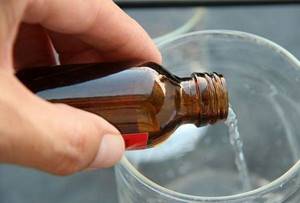
How to clean
Any adequate actions aimed at cleaning the kitchen hood from grease come down to attempts to dissolve the dirt and wash it away without using brute force on the metal. Abrasive materials and hard brushes can damage the grille and its surface, which will unforgivably increase the rate of contamination, and the filter may become deformed and no longer fit into its seat or simply sag, spoiling its appearance.
To clean your kitchen hood, follow these instructions:
- De-energize the device. You need to unplug the power cord from the outlet, turn off the circuit breaker in the distribution panel responsible for the electrical equipment in the kitchen. The option with a built-in switch does not count.
- According to the hood instructions, locate all grease trap fasteners. These are two to four fasteners with latches, which are moved to the “open” position, and then remove the bottom cover. Typically there is a handle that you can grab at the front, and on the back there are several grips in the grooves from which the panel is removed by pulling it forward.
- If possible, remove the grease trap grate from the panel with a small frame or no frame at all. This will make it easier to clean, especially if you have to cook it, but more on that later.
- Check the pipe leading from the fan assembly to the exhaust vent. If it is an aluminum corrugated pipe, then it is easier to replace it over time; dismantle any other option and wash it from ash and soot.
- Using a slightly damp sponge and dish detergent, wipe the entire interior and exterior of the hood. Exceptions are places with laid wiring and electrical units; usually they are additionally protected and do not get dirty.
- Clean the grease trap grate using one of the methods listed below and dry it.
- Install all hood elements in reverse order.
It remains to determine the best option on how to clean the hood grate from dirt and grease. Depending on what set of chemicals is available. means, the appropriate method is selected, and, as practice shows, there are quite a few of them.
Method number 6. Cleaning with vinegar
Every housewife knows that soda and vinegar are unique means for cleaning anything. The main thing is that there is no harm to health from them, and they are always available in the house.
Procedure:
- open the window and put on gloves;
- moisten a sponge or rag in a 9% vinegar solution and thoroughly wipe all dirty areas. You can place the filter in a baking tray and fill it with vinegar solution;
- leave for 10-15 minutes;
- brush and rinse thoroughly.
A 9% vinegar solution may not cope with serious stains. If your case is advanced, it is better to take undiluted food grade acetic acid (70%). For medium stains, a 70% solution can be diluted 1:1 with water.

Vinegar
Acetic acid removes even old, stubborn fat. You will need to soak a washing up cup in pure vinegar and blot the grates thoroughly. After 10 minutes, use the same sponge to scrub the grates. During this time, the vinegar will well dissolve the stubborn fat and it will become more amenable to cleansing. Remember - vinegar has a pungent odor and can damage the skin, so make all manipulations with gloves.
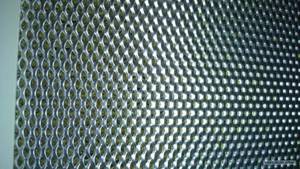
Household chemicals for cleaning grease and deposits on hoods
If there is any contamination on your kitchen hoods, you can spend money and purchase special cleaning products and detergents. They are excellent at removing grease residue and cooking splashes. Such preparations can be either powdered or liquid formulations.
Review of household chemicals: how to effectively wash kitchen appliances
“Grandma’s” recipes cannot always help effectively cope with pollution. In this case, you should pay attention to industrial cleaning products.
| Product name | Description of the drug | Average price rub. |
| Kaneyo cleaning liquid | Effectively removes greasy stains and old deposits from metal and ceramic products. Also suitable for metal enamelled surfaces. The product effectively removes carbon deposits on kitchen hood grates. | ₽ 385 |
| Grease remover Unicum | It will help to cope with greasy deposits on the body and internal parts of the hood. Sometimes it requires additional cleaning. | ₽ 200 |
| Active foam FLAT | Suitable for various kitchen electrical appliances. The product is suitable for any surface and quickly removes grease from them. | ₽ 170 |
| Delta Effect | Concentrated universal product for grills, ovens and hoods. Removes accumulated fat. | ₽ 450 |
| Nettoyant inserts ETAMINE DU LYS | Liquid for hoods and grills. Effectively removes even the oldest carbon deposits. It contains acids, so it should be used with caution on metal products. | ₽ 600 |
General disassembly procedure
In order to thoroughly rinse not only the visible surfaces, but also the internal parts of the hood, it must be disassembled. The electric or gas stove over which the hood is located is covered with cloth, film or paper so as not to stain or lose the hood parts. How to properly dismantle hoods of different types and manufacturers is indicated in the instructions, but, as a rule, the following steps are followed:
- First you need to remove the top part of the case or decorative panel.
- After this comes the turn of the grease trap mesh, which protects the internal cleaning device.
- Next, remove the air or carbon filter.
- If the design provides for an air duct pipe, remove it.
- To make it easier to get to the internal parts, the hood is removed from its mounts to the cabinet, wall or ceiling.
- The motor and fan are removed after first removing the protective cover (this usually requires unscrewing the bolts).
Small parts and fasteners must be carefully folded so that there are no problems during reassembly.
Method No. 7. Lemon juice cleansing
If acetic acid is capable of corroding fat, then why not use other acids used in everyday life. For example, citric acid.
Procedure:
- Peel 1-2 lemons, cut them into halves and rub them on the dirty filter. In the absence of lemons, use citric acid (3 tablespoons per 1 liter of water);
- leave for 20 minutes; in case of heavy contamination, it is better to soak the filter in a solution of citric acid and leave for several hours or overnight;
- clean, rinse and dry the filter.

For those who give up: how to remove heavy dirt from the hood
If you were unable to remove the blockage using any of the above methods, then you will have to use more serious means to remove old fat. In this case, you need to purchase professional chemicals that can cope with long-term pipe blockages.
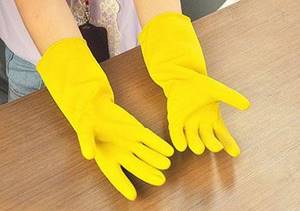
Be sure to wear gloves on your hands when working with chemicals. These drugs are sold in the form of a gel, granules or powder. After carefully reading the instructions for the selected substance, treat the removable panels of the hood and leave for several hours for effective removal. Then, under warm water pressure, remove any remaining grease and dirt using the hard side of the sponge.
Method No. 11. White
White is often used to clean the body of the hood from grease, but it will also cope with filters, although it is unlikely to be able to clean serious contaminants.
Procedure:
- wet the filters;
- Apply white to the filter using a toothbrush for 10-15 minutes;
- Use a brush to remove grease and rinse the filter.
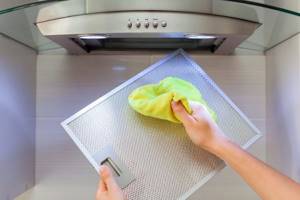
Concentrated saline solution
Household salt in the form of a concentrated solution perfectly removes greasy scale on the exhaust hood grille. You must first prepare a hot composition based on table salt. After that, dirty elements and parts are soaked in the mixture for 30 minutes. The composition can be heated over low heat, but not brought to a boil.
If the contamination cannot be washed off the surface by the element, it is better to treat them with citric acid or juice.
Once the desired result is achieved, the internal parts are washed in ordinary and then running water. If the composition washes away the residual products, then all that remains is to dry the components and elements. But how to clean the hood from grease if there are small problem areas left? It is better to treat such areas with a consistency of laundry soap or lemon juice.
How to clean the hood body?
Any housewife wipes the outer part of the hood much more often than she washes the hood filters, so that a layer of dirt does not accumulate there. You can remove plaque using regular dishwashing detergent. It is applied to a damp sponge, foamed and the dome wiped with the sponge. You can leave the foam for a few minutes, after which it is carefully removed with a damp cloth, and then wipe the hood dome dry. Probably, this simple method is familiar to every housewife. You can replace the detergent with window cleaning liquid - it dissolves plaque well and makes the surface shine.
If the hood body has not seen proper care for some time, then the following methods will be useful to you:
- cleaner for ovens, hoods and microwaves in the form of a spray or liquid;
- a mixture of soda ash (3 tbsp), silicate glue (100 ml) and washing powder (0.5 tbsp), which are dissolved in a glass of warm water. After thorough mixing (you can use a plastic bottle to shake well), the product is applied to the surface, you can leave it for 5-7 minutes, and then remove the composition along with any dirt that has fallen off the body. The product helps even in advanced cases;
- Rub the surface with half a lemon, leave for a while, then wash off the juice with a damp sponge.
It is better not to use abrasive detergents and hard brushes to avoid scratching the surface. If there is heavy dirt, you can remove it using a plastic scraper.

Methods for cleaning the grease filter:

A grease filter that is not very dirty can also be thoroughly washed in the dishwasher . To do this, the filter cassette must be installed vertically and the machine must be turned on in normal mode. It is true that washing dishes, especially heavily soiled ones, is undesirable, since the filter meshes can be clogged with food residues, which will then be extremely difficult to wash.
When cleaning, you need to use available means (not hard brushes, rags, soft sponges) very carefully; using excessive force can damage the filter mesh. After this, the filter must be dried and put back in place.
How to clean the grates of the hood from grease if the filter meshes are completely clogged with layers of dirt, which has also become “petrified” from time and exposure to hot air. Simple flushing will not help; more radical measures must be taken. In this case, the grease from the hood filter can be cleaned using:
- Baking soda. It is necessary to select a container suitable in size for placing the filter, make a soda solution (at the rate of 1 - 2 tablespoons per 1 liter, gradually pour into boiling water), boil the filter in the soda solution for half an hour. The boiling time, as well as the concentration of the solution, can be changed depending on the degree of contamination of the filter. After the solution has cooled slightly, remove the filter and rinse thoroughly with running water.
- Ammonia. If it was not possible to completely clean it with soda, an aqueous solution of ammonia (2 teaspoons per liter of water) will help. Place the filter cassette in this solution for a quarter of an hour (ammonia actively breaks down fats), then rinse well with clean water.
- Vinegar essence. Effectively softens and dissolves old fat deposits. You need to thoroughly wet the filter mesh with essence, repeat this procedure several times if necessary, then rinse the filter cassette in clean hot water, rinse in soapy water, again in clean water and dry.
- Lemon acid. Place the filter cassette in a solution of citric acid (about 1 tablespoon per liter of water, but the concentration can be varied), after 15 - 20 minutes visually inspect the filter, if cleaning is successful, this will be clearly visible on the brightened surface of the aluminum. Wash the remaining fat first with a soapy solution, and then under strong pressure of clean water and dry. The filter is ready to be reinstalled. You can also use squeezed lemon juice for this purpose. To do this, you need to generously soak the contaminated mesh with lemon juice several times, and when the fatty deposits soften, wash them with water in the same order.
- Salt. Place the grease filter in a well-concentrated hot saline solution (1 - 2 tablespoons of salt per liter of water) for about 15 - 20 minutes, the salt perfectly corrodes the fat, then rinse under pressure with clean water.
Important: when preparing a soda solution, you cannot pour soda into boiling water in large portions, since the resulting bubble foam can cause a burn injury.
If the so-called traditional methods are unsuccessful, and the filters cannot be completely cleaned with their help, it’s time to use special chemicals . Currently, there are several special products on the market designed for cleaning filters. For example, Pyramida has good cleaning properties for grease filters with aluminum mesh (foil). It comes in the form of a spray, which simplifies the work. Simply spray the product onto the surface to be cleaned and rinse with water after a while. Does not react with aluminum. Features of its use are described in the instructions.
Disposable grease filters are produced on non-woven, padding polyester, acrylic or other synthetic microporous fabric base. Their name corresponds to the actual state of affairs, since when they become dirty, they cannot be cleaned (washed) and need to be replaced with new filters. In some sources you can find a statement that acrylic fabric on filters can be washed, but it must be taken into account that the air throughput is almost halved, so the hood will work under heavy load with this cleaning method.
After cleaning the grease filters, the cassettes must be replaced and secured securely. After this, you need to check the operation of the kitchen hood; if there are no unusual noises or vibrations, it means that it is assembled correctly and can be used further for its intended purpose.
How to clean an air duct?
This item is relevant for owners of flow-through hoods. Reduced draft may be evidence that fat has accumulated in the air duct. Even if everything is in order with the draft, it doesn’t hurt to check the condition of the air duct once every year or two.
Air ducts are:
- round or square plastic;
- round corrugated aluminum.
The first ones consist of several parts and are easy to disassemble. Simply wash them with soapy water and rinse thoroughly. They are easy to clean.
Corrugated pipes are cheaper, are used more often, but collect grease much better. Fat settles and accumulates in numerous folds. It is often easier to replace a pipe than to clean it. If you have a steam cleaner in your home, use it. As a last resort, the pipe can be cleaned with “Mole” or a similar product, but it will need to be rinsed very thoroughly.
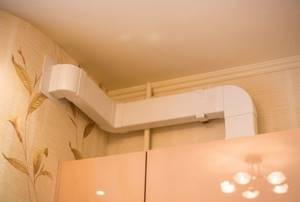
Features of air duct care
When “generally cleaning” the hood, you also need to pay attention to the air duct pipe. The pipes are not so narrow that settled dirt will hinder the operation of the hood, but grease particles accumulate on the walls, which are best removed regularly. The air duct is cleaned approximately every two years.
Air ducts for hoods can be plastic or corrugated. Duct maintenance will vary depending on the type of duct.
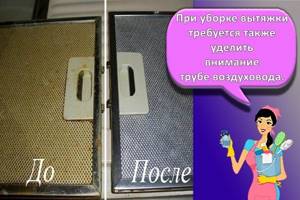
Plastic rectangular or round
Plastic air ducts are made of rectangular or round cross-section. Their dismantling is not difficult since they consist of individual plastic segments that are easy to assemble and disassemble. Wash thoroughly with soapy water, then with running water, and dry well before reinstalling.
See also
How to clean a chimney (chimney in a private house) from soot with your own hands
Corrugated
A corrugated air duct is somewhat more difficult to maintain, since more contaminants settle on the corrugated surface than on a smooth plastic one. Made of aluminum, such an air duct is easy to install and costs less, which is why many people prefer them. If the pipe is long and difficult to clean, you can simply replace it with a new one.
The corrugated air duct can be cleaned without completely dismantling it. To do this, separate its end from the hood and clean it with a brush and soapy water, as long as the brush is long enough.
Steam cleaner
Steam will help you easily deal with fat deposits by dissolving them. At the same time, the steam cleaner does not provoke corrosion. After steam treatment, the pipe is washed with a soap solution, clean water and dried.
"Mole"
“Mole” has a less gentle effect, but it will effectively wash away all contaminants. Apply it to the contaminated surface of the air duct for half an hour, then wash off. If necessary, process in this way several times.
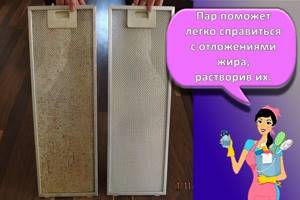
How to clean the fan and motor?
They need to be cleaned once every 1-2 years; first, it is better to study the instructions for the hood in order to understand where the elements you are looking for are located and how they are attached. After the filters are removed, you need to unscrew the mounting bolts, remove the fan and motor, and then disconnect the fan from the motor. The fan impeller can be soaked in a soapy solution for a couple of hours, after which the soaked fat can be carefully removed.
The motor itself cannot be wet, but with a damp sponge, without touching the wires, you need to remove most of the dust and dirt. After this, the engine can be lubricated.

Cleaning individual hood parts
To clean individual parts of the kitchen aid, you need to know how to disassemble the hood in the kitchen to wash it. A kitchen hood consists of a grease trap, an air duct, a motor and a fan. Before thorough cleaning, it is better to disassemble the device.

They do this in the following order:
- To begin, cover the stove and furniture under the hood with film so that during disassembly and cleaning of the structure, contamination does not get onto other surfaces.
- Then disconnect the device from the power supply.
- Then press the plastic clip to remove the grease trap.
- If the hood model allows it, remove the air duct.
Each part can then be cleaned individually.
Cleaning the filter
First, let's figure out how to clean the filter in the kitchen hood. The filter is a metal mesh on a durable frame. It is the multilayer mesh that retains most of the fat. The filter device is made of galvanized steel, so it is not subject to corrosion. Thanks to this, the part can be washed and boiled.
The filter cleaning process looks like this:
- Pour water into a large boiler (slightly larger than the size of the grate).
- Instead of water, you can use a homemade solution, the preparation process of which we described above.
- The liquid in the pan should boil. Make sure all ingredients are completely dissolved.
- After this, place the filter in a saucepan and boil it over low heat for an hour.
After boiling, rinse the filter under running water. For a better effect, you can additionally wash the filter device in the dishwasher or rub it with a soft brush.
Cleaning the hood body
Usually the housing is not as dirty as the filter. As a rule, grease splatters from cooking can accumulate on it. The surface is wiped with dishwashing detergent. After this, wash with a damp sponge and wipe dry.

Old fat deposits can be dealt with in the following ways:
- Turn off your electric or gas stove to protect yourself while working.
- Treat the surface with any product designed for cleaning stoves and ovens, for example, Schumanite.
- Instead, you can use a homemade solution. To do this, dissolve 90 grams of soda, 100 ml of silicate glue and 15 g of washing powder in one glass of water.
- After applying any product, give it time to work.
- Once dissolved, the fat can be easily washed off with a damp sponge.
- To prevent streaks from remaining on the case, wipe it dry with a towel.
Cleaning the fan and motor

The motor and fan should be cleaned once or twice a year. The instructions for each device provide instructions for removing these structural parts. As a rule, to remove the motor and fan, you need to unscrew the mounting bolts. After this, the motor is disconnected from the fan.
For washing we use a solution of laundry soap. Soap shavings are dissolved in a small amount of warm water. The impeller is soaked in this solution for an hour. After this, the dirt is additionally removed with a sponge or brush. The impeller is washed and dried well.
The outside of the motor can be gently wiped with a damp cloth and wiped well with a dry cloth. You can only reinstall the impeller and motor after you are sure that they are completely dry.
Preparation
The hood should be cleaned after disassembling it into its component parts. Before doing this, you need to read the instructions for the device. Then turn off the hood from the electrical network and proceed sequentially:
- Open the case by unlocking the latches.
- Remove the filter.
- Remove the exhaust pipe. It is important to pay attention to what it is made of. Not every material can be washed. Information about this can be found in the instructions for the hood.
- Then wash each part, along with the body itself, in the bathroom, first soaking it in a solution with detergent.
Don't forget that the surface of the hood also needs to be cleaned. The washing solution is prepared in a ratio of 1:4, where water accounts for four parts, and a cleaning agent, for example Fairy, accounts for 1. A regular sponge is used for cleaning. Afterwards, all structural elements are wiped dry.
How to disassemble a hood for cleaning
The hood is an important assistant in the kitchen; it must be kept clean. Improper care leads to moisture and odors. The frequency of cleaning depends on the intensity of use of the device. It is recommended to adhere to the following deadlines:
- weekly cleaning of kitchens in public catering establishments;
- Clean your home hood every 1-3 months.
Don’t delay cleaning - removing old grease and carbon deposits is difficult and time-consuming.
Before cleaning, you must unplug the equipment and disassemble it. Study the technical documentation to determine the nuances of removing individual sections. Prepare a container for removable parts, kitchen furniture and clear the working surface of the stove.
Parsing scheme:
- Release the retaining clips.
- Remove the grille from the grooves.
- Unscrew the mounting bolts.
- Remove the filter. In some models it is hidden behind a metal grille.
- Remove the pipe.
- Remove the air filter inside if your unit has one.
Inspect the parts to assess the extent of contamination and select a grease cleaning option.

How to clean a clogged kitchen hood filter
In most models, cleaning the filter means washing out clogged grilles, as described above. But there are models that contain an additional carbon filter. They cannot be cleaned, just as they cannot be boiled. If this is done, the filter element will lose its properties. Well then how to clean it?
Answer: no way, it cannot be cleaned, but replaced. To do this, you should find the hood filter, which is located behind the catcher. It looks like a round or rectangular case made of plastic or metal, in which a special filter bag is placed. The box should be opened and the tab replaced.
Important! The service life of such a filter is up to 3 months, after which it loses its air purifying properties.
